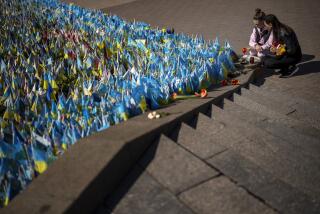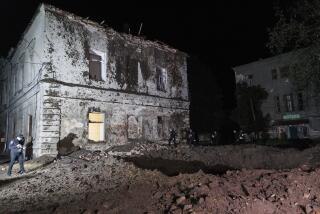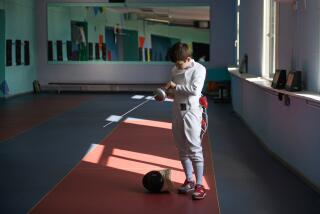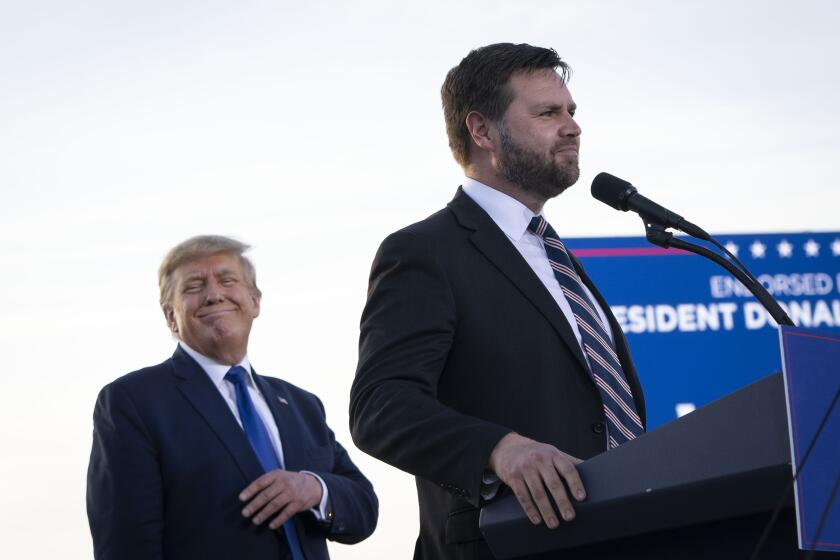Op-Ed: It’s not only human lives being upturned by the Russian invasion

The humanitarian crisis created by the Russian invasion of Ukraine has entered its second month and resulted in more than 4 million refugees and 6.5 million internally displaced people. Social media is filled with images of a population in motion, and fleeing residents are taking their pets — rabbits, cats, dogs, parrots and snakes — with them.
These are the people who realize that they are not returning home anytime soon. I’ve seen Ukrainians make desperate pleas on social media to residents in places like Mariupol, imploring those remaining behind to check on pets entrusted to family and friends, who themselves had to flee or have not been heard from in days.
As a veterinarian who trained in Kyiv, I do believe that Ukrainians have an unusually strong bond with their pets and animals in general, which carries over to their distress in this catastrophic war.
In the United States and Canada, emergency disaster relief systems have gradually, over the years, planned for animal rescue as part of responses to events, recognizing that people hesitate to evacuate without their pets. Fortunately, some European countries have eased travel restrictions on animals accompanying Ukrainian refugees crossing their borders.
Tatyana, a Ukrainian woman who operates a kennel in her homeland devoted to Nova Scotia “tollers” is living in an underground bunker while her city is under siege. She longs to be back at work.
For decades, public transportation systems in Ukrainian cities allowed people to travel with their well-behaved pets, including large-breed dogs. The babushkas carried their small dogs securely in shoulder bags on walks and shopping trips. Cats and rabbits too accompanied their humans on visits to families in the countryside.
Hanna Hopko, a former member of the Parliament in Ukraine, hesitated to get her daughter a guinea pig this January, as evacuation was imminent. Eventually, understanding that it’s feasible to evacuate with a guinea pig, she gave in and got one. But just as Hopko feared, in February an exodus began. Reports and pictures from my friends leaving Kyiv were harbingers of what was to come — that animals too would be displaced in massive numbers.
Photograph-filled posts found by searching social media for “Ukraine pets” show countless evacuees carrying their pets, alongside children, as they left for relative safety elsewhere. An older woman in a wheelchair is holding on to her chihuahua; a mother of young children has strapped her German shepherd onto her back; a man who has lost family members finds his cat in the rubble that used to be his home and village. As a photo essay in the Atlantic showed, animals can be refugees too.
Many Polish veterinarians are providing round-the-clock care for refugees’ pets and rescued animals; some Ukrainian veterinarians have stayed back to care for animals left behind. American and Canadian veterinarians are traveling to Ukraine and Poland on their own time and expense for relief efforts.
The American Veterinary Medical Foundation along with Merck has pledged to donate $200,000 for Ukraine relief. Veterinarians Without Borders, in Canada, was recruiting a program manager for Ukraine response.
A video of a young man driving a van with the seats taken off, to transport a mob of kangaroos from a zoo to safety, went viral and garnered media attention in multiple countries, even in those where media coverage of the war is muted, attesting to the unique potential that animals have in bringing people together. This modern-day Noah, who has been evacuating zoo animals since the start of the war, is not alone anymore — volunteers from European nations have traveled to Ukraine to rescue bears, lions and other unusual animals that were stranded or at risk of being killed.
Ukrainians’ life is a nightmare, as people scramble to leave the capital for safer cities amid war.
But these human-animal bond stories from Ukraine conspicuously lack news about a large section of the animal population: livestock. Farm animals — dairy cows and calves, horses, poultry, pigs, sheep, goats — need to be fed, watered and maybe milked on time. Some families have already done the unimaginable: turned out their horses, setting them free out of desperation. There were 2 million heads of cattle and 6 million pigs in Ukraine in 2020, but we know very little about what is happening in the countryside. How are supply chains affecting animal feeds? How has displacement affected farm labor, which affects the welfare of millions of these animals?
I first learned that Vorzel, a village not far from Kyiv where I did my farm medicine practicum as a veterinary student, was occupied by Russian troops when friends forwarded the transcript of a speech by a former mayor of Irpin, the nearby city. I imagine animal carcasses littering the bombed rural landscape — another horrifying aspect of the Russian invasion.
Veterinarians understand that the human-animal bond is manifested in myriad ways. Whatever the long-term results of this devastating war, one thing is visibly circular: Human suffering begets animal suffering begets human suffering.
Malathi Raghavan is a clinical associate professor at Purdue University College of Veterinary Medicine. She earned her doctor of veterinary medicine from the Ukrainian State Agricultural University in Kyiv.
More to Read
A cure for the common opinion
Get thought-provoking perspectives with our weekly newsletter.
You may occasionally receive promotional content from the Los Angeles Times.












